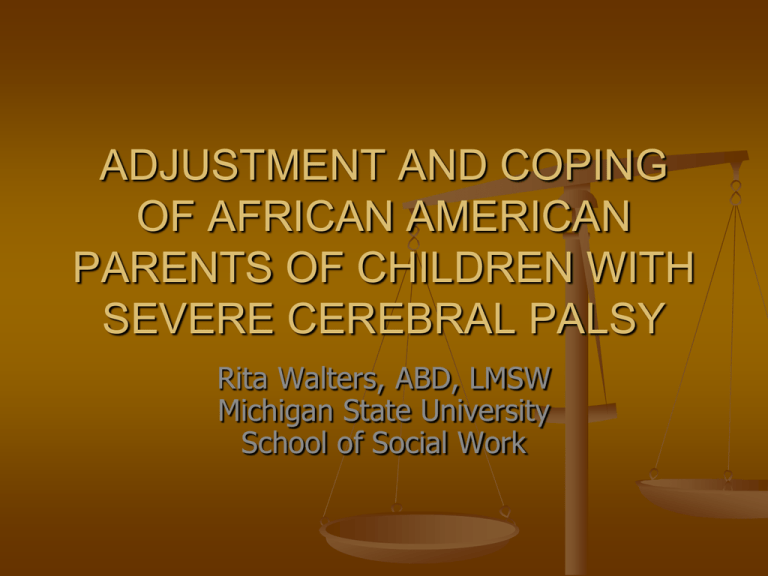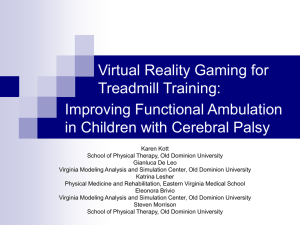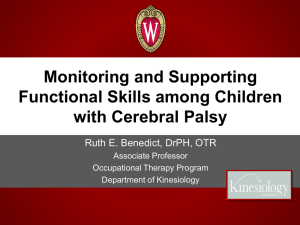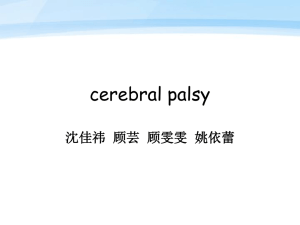AUCD Electronic Powerpoint Presentation
advertisement

ADJUSTMENT AND COPING OF AFRICAN AMERICAN PARENTS OF CHILDREN WITH SEVERE CEREBRAL PALSY Rita Walters, ABD, LMSW Michigan State University School of Social Work BACKGROUND The prevalence of cerebral palsy is highest in Black, nonHispanic children at 4.2 cases per 1,000, compared with 3.3 cases per 1,000 among White, non-Hispanic children. Children born to families of lower and middle socio-economic status have a higher prevalence of cerebral palsy than children born to families of higher socio-economic status. The prevalence of mild cerebral palsy is similar for Black and white children; however the prevalence of severe cerebral palsy is 70% higher in Black children than white children. The higher incidence of cerebral palsy among African Americans is not associated with maternal or birth characteristics, but instead may be attributed to other factors, such as the negative effects of racial discrimination, poverty, substandard housing and neighborhood conditions, and insufficient availability of and access to quality health care. ABSTRACT Based on the assumption that cultural beliefs and values influence African American parents in how they care for a child with disabilities; greater knowledge of these families would allow for the improvement of existing services and the development of new strategies to sustain caregivers in their vital roles. The primary purpose of this study is to contribute to knowledge about African American parents of children with severe cerebral palsy. The rationale for this study is threefold. First, there is essentially no information in the literature regarding African American parents of children with severe cerebral palsy. Second, it is not clear to what extent cultural values and beliefs impact on the provision of care and perceptions of the child with severe cerebral palsy. And lastly, it is not clear what formal and informal supports are desired or used by African American parents caring for children with severe cerebral palsy. Studies on Adaptation and Coping of African American Parents of Children with Disabilities STUDY PURPOSE SAMPLE RESULTS Ha, Greenberg & Seltzer (2011) To examine the extent to which the impact of parenting a child with a disability on African American parents’ well-being differs depending on the level of positive and negative social interactions with family members other than spouses. 48 parents of children with a disability and 144 comparison group parents of nondisabled children. Parents who have lower levels of positive support from family members are more likely than the comparison group to have negative mental health profiles, and those who have higher levels of positive family support are more likely than comparison group parents to have positive mental health profiles. Magana & Smith (2006) To compare the health of older mothers who were co-residing with a child who had a developmental disability to the health of same age mothers without caregiving responsibilities. 162 Latina and Black American women who co-reside with a child who has a developmental disability and 2,754 Latina and Black American women who do not co-reside with a child with a disability. For both groups, older adult caregivers were more likely to report having limitations from arthritis than their noncaregiving counterparts. Caregiving was associated with more depressive symptoms for Latinas, but this relationship was not found for Black American women. Studies on Adaptation and Coping of African American Parents of Children with Disabilities STUDY PURPOSE SAMPLE RESULTS Miltiades & Pruchno (2002) To examine the effect of religious coping on caring for adults with developmental disabilities 71 African American caregivers to a matched sample of 71 White caregivers. African American caregivers use more religious coping and that religious coping was positively related to better caregiving satisfaction. Stueve et al (1997) To determine how African American caregivers and white caregivers of persons with severe mental illness differ in emotional well-being 43 African American, 44 Hispanic, and 93 white caregivers of persons with severe mental illness African American caregivers reported lower levels of burden and lower levels of grief than the other two groups. Picket et al (1993) To compare the coping mastery ability and self-esteem scores of Black and white parents of severely mentally ill offspring to determine the different effects of caregiving on these 2 groups of parents. 24 African American parents and 185 white parents of adults with serious mental illness African American parents had higher levels of coping mastery and self-esteem and lower levels of depression. PURPOSE This research is intended to learn about the lived experiences of African American parents of children with severe cerebral palsy, how they are impacted by caring for a child with severe cerebral palsy; and what support systems they utilize. The design of this study identifies with the strengths, values, and traditions of the African American family and proposes a mechanism for which to apply those characteristics to a specialized group, in this case African American parents of children with severe disability. Significance of the Study It has the potential to close gaps in the literature by presenting the perceptions and experiences of African American parents of children with severe cerebral palsy; which is critical as African Americans are at a greater risk for cerebral palsy and the severity of the condition. Professionals may gain an extensive understanding of the unique characteristics and strengths of African American parents of children with severe disabilities in order to develop comprehensive treatment plans and delivery of service that reflects cultural competence and sensitivity. An additional value of this research is that African Americans may feel valued in sharing their experiences; and viewed as experts on caring for their child with severe cerebral palsy. RESEARCH QUESTIONS The overarching research questions that will guide this study are: What types of health problems do African American parents experience as a result of caring for a child with severe cerebral palsy? What kind of positive and negative statements do African American parents make about caring for a child with severe cerebral palsy? What types of informal and formal community resources do African American parents caring for a child with severe cerebral palsy utilize? METHODS This exploratory qualitative research study used the African American Families, Religion, and Disability model as the conceptual framework; combined with a phenomenological approach as a theoretical framework to shape the research study design with thematic data analysis based on grounded theory. Conceptual Framework: Rogers-Dulan & Blacher Model Religion, Ethnicity, and Disability: African American Families Common practices and beliefs among African American families Decision-making and parenting roles in Black families may be shared not only by mothers and fathers but also with grandparents and relatives from the extended family network. African Americans engage in religious activities more frequently and express higher levels of religious beliefs than any other racial group in the United States. DATA COLLECTION Utilizing a purposive sampling method and snowballing technique, 15 African American parents of children ages 5 to 18 with severe cerebral palsy was recruited for the study. Data was gathered using an in-depth semistructured interview that focused on three areas: health, cultural values and beliefs, and social support. Participants completed two questionnaires for the purpose of developing a demographic profile of participants. Preliminary Findings Parents are reluctant to participate in research: Overwhelmed in daily responsibilities; not willing to add non-required activities to schedule Desire immediate help in role as caregiver; long-term benefits not appealing Religious beliefs and spirituality are greatly valued, even though parents may not regularly attend church or fully participate in church related activities Rarely seek out formal support services beyond child’s education and health care providers References Hill, R. B. (2003). The strengths of Black families (2nd ed.). Maryland: University Press of America Martin, J.A., Hamilton, B.E., Sutton, P.D., & Ventura, S.J. (2010). Births: Final data for 2008 National Vital Statistics Reports, National Center for Health Statistics, 59(1). McAdoo, H. (2007). Black families. Thousand Oaks, CA: Sage Publications. Rogers-Dulan, J., & Blacher, J. (1995). African American families, religion, and disability: A conceptual framework. Mental Retardation, 33(4), 226238. Wu, Y. W., Xing, G. Fuentes-Afflick, E., Danielson, B., Smith, L. H., & Gilbert, W. M. (2011). Racial, ethnic, and socioeconomic disparities in the prevalence of cerebral palsy. Pediatrics, 127(3), e674-e681. Yeargin-Allsopp, M., Van Naarden Braun, K., Doernberg, N. S., Benedict, R. E., Kirby, R. S., & Durkin, M. S. (2008). Prevalence of cerebral palsy in 8year-old children in three areas of the United States in 2002: A multisite collaboration. Pediatrics, 121(3), 547-554. Contact Information Rita Walters, ABD, LMSW Michigan State University School of Social Work Baker Hall 655 Auditorium Rd East Lansing, Michigan 48824 517-256-0091 walter99@msu.edu











